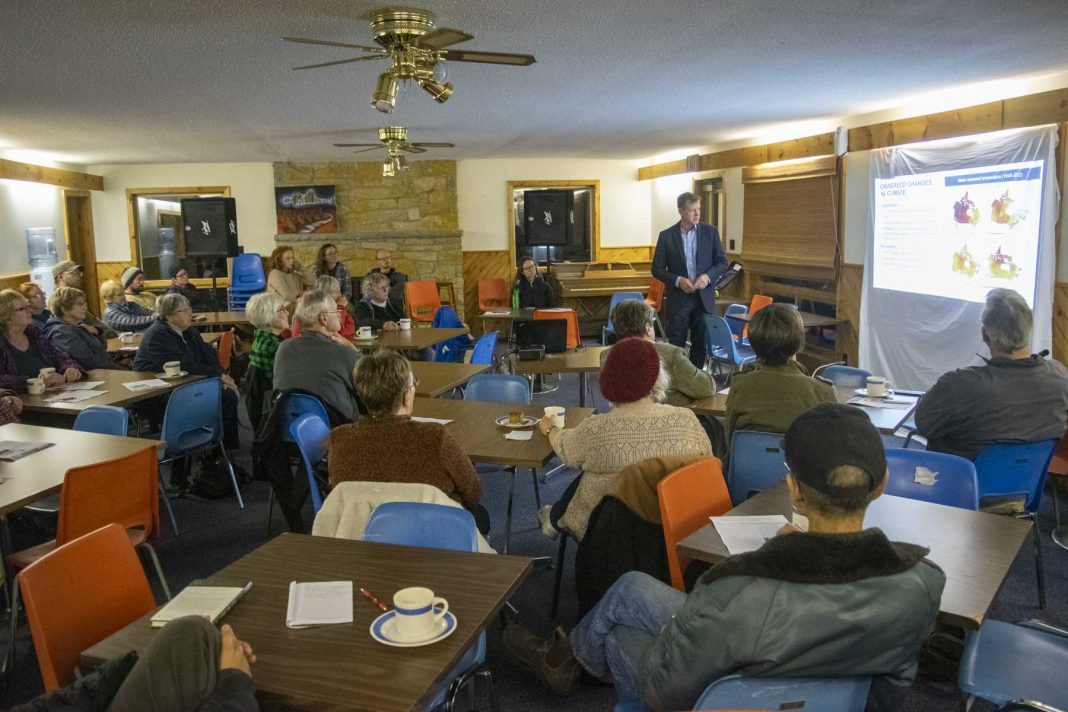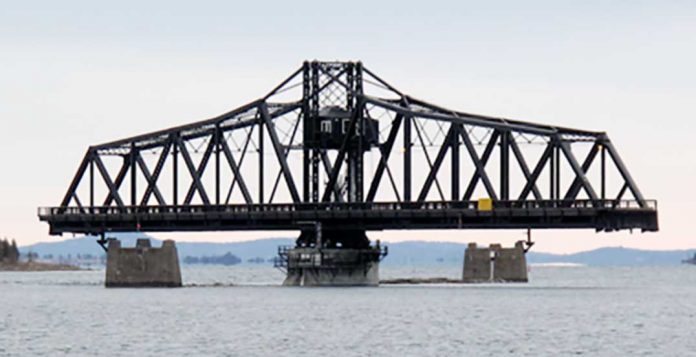HONORA BAY—Two dozen concerned Islanders attended a special meeting held recently at Café in the Woods where Climate Risk Institute president Al Douglas discussed the impacts of climate change on Manitoulin Island and what can be done to manage those risks.
“I was very impressed with the talk Al Douglas did for Manitoulin Streams and Misery Bay recently. I thought everybody should have the opportunity to hear him and discuss climate issues. I see it as very pressing,” said event organizer Jan McQuay.
The Expositor reported on that presentation in its October 23 edition and this information was similar in many ways.
“Everybody talks about the (oceanic) coasts; this is a little more zoomed-in on what will happen here in Ontario if we don’t get our act together,” said Ms. McQuay while introducing the event.
She invited the climate change co-ordinator for the townships of Billings and Central Manitoulin, Kristin Koetsier, to inform the room of her upcoming public climate change open houses in her respective townships at 7 pm on both nights.
The Central Manitoulin event is at the community hall in Mindemoya on December 2 and the Billings event is at the Park Centre in Kagawong on December 4. People from across Manitoulin are welcome to attend, not necessarily just residents of those townships.
Mr. Douglas spoke next. Through a set of 54 slides he explained the trends in measured climate change, as well as possible future emissions scenarios. The current ‘worst case’ scenario is known as representative concentration pathway (RCP) 8.5 and is reflective of what would occur if emissions continued at their current rates.
Mr. Douglas showed how temperatures have changed in Canada from 1948 to 2012, including the country-wide average raise of 1.7 degrees Celsius—double the global average. In the northwestern part of the country, winter temperatures have raised by four to six degrees Celsius in that time.
From 1951 to 2017, climate researchers on the American side of the Great Lakes measured a 1.3°C rise in temperature, 16 more frost-free days per season, a 14 percent increase in total precipitation and a 35 percent increase in heavy precipitation events.
Mr. Douglas also showed charts that demonstrate how human impacts will make extreme weather events more likely, moving their chances from one in 60 to one in five.
The presentation also discussed climate change at a local level. Using data from the Gore Bay weather station compiled by Risk Sciences International, predictions for Manitoulin Island’s climate into the 2080s showed steadily rising temperatures and rainfall, shrinking snowfall, increased annual precipitation as a whole and much more severe droughts in the summer months.
The average number of days above 30°C per year in Gore Bay is expected to rise from 5.3 in the 2020s to 38.5 in the 2080s. Going forward, a one-in-20-year storm is likely to become a one-in-10-year storm. Extreme hot temperatures, extreme weather, reductions in snow and ice cover, increased drought, forest fires and flooding are all expected to worsen.
Much work has been ongoing on the Island to determine what impacts are being seen on a local scale. Liam Campbell of Manitoulin Streams Improvement Association has been gathering large amounts of data and speaking with people across the Island together their perspectives on the issue. This project is known as the Island-wide climate change risk assessment.
“You can’t measure the change in risk if you don’t know where you’re at right now,” said Mr. Douglas, before issuing a call for citizens on Manitoulin to share any climate records they may have with Manitoulin Streams. One audience member mentioned the late Allan Tustian who kept records of Lake Mindemoya ice thickness as an example of the kind of information that could be useful to researchers.
Mr. Douglas then discussed the adaptation strategies that may help, stressing that preventing extensive climate change is most effective. “The best form of adaptation is mitigation,” he said.
The rate of climate change is much faster than trees and wildlife species can adapt, so planners have been preserving north-leading green spaces for plants and trees to move north as the climate range shift.
However, since trees especially cannot keep up, some groups are planting native trees at the north edge of their survivable ranges to help them keep up with climate change.
When lakes no longer freeze over, mass evaporation occurs in winter months as open water meets cold, dry and breezy air. With warmer temperatures, pests and invasive species will be able to better survive the winters that normally kill them off.
There are five key takeaways on the problem of climate change that Swedish professor Kimberly Nicholas stated, which Mr. Douglas shared: the climate is warming, it is human-caused, science is sure of this, the problem is bad, but it is correctible.
There are a variety of steps that individuals, organizations and governments can take to address issues related to climate change. Some include better management of stormwater, offering residents protection in extreme heat events, factoring in future climate projections in engineering, designing neighbourhoods to be wildfire resistant and preserving ecosystems such as forests and especially wetlands.
“If we do it right, we can set an example for the world. I think there’s merit in that and if we do it right, we can create jobs and be responsible for the innovations the rest of the world can adopt,” said Mr. Douglas.
“Everybody has a role to play to mitigate and adapt to climate change,” said Mr. Douglas.
Ms. McQuay encouraged everyone to visit the Environment and Climate Change Canada website to learn more about the risks associated with a changing climate and what individuals can do to help combat the problem. She also thanked Justin and Kerrene Tilson for offering the meeting space free of charge for the climate change talk.
The federal climate change portal can be accessed at Canada.ca/en/services/environment/weather/climatechange.html.





